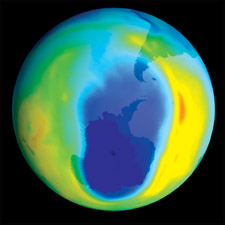
Special day for the ozone layer
Ozone,
ozone layer, chloro-fluoro carbons... these may be words that you know
well. You may have heard these words before and would be hearing them
and reading about them once again this week. Why? Because today,
September 16, is the International Day for the Preservation of the Ozone
Layer or World Ozone Day as it's also known.
This year, the event is even more relevant as it marks the 20th
anniversary of the signing of the Montreal Protocol on Substances that
Deplete the Ozone Layer, the international treaty to protect the
stratospheric
|

Old refrigerators were responsible for releasing CFC gases |
ozone layer. So, aptly, this year's event is observed under the
theme 'Celebrating 20 years of progress in 2007'.
In recognition of the importance of this Protocol and its
achievements, various activities are being planned by countries across
the world to celebrate this event and to further raise awareness on the
protection of the ozone layer. Sri Lanka will also hold many events
spearheaded by the Environment Affairs Ministry.
The Montreal Protocol, which was first signed in the city of
Montreal, Canada on September 16, 1987, encourages countries to phase
out the production and consumption of ozone depleting chemicals; around
191 countries have already signed it.
It includes guidelines such as countries phasing out their annual
consumption of harmful substances such as CFC and R22.
The International Day for the Preservation of the Ozone Layer was
proclaimed as September 16 by the United Nations General Assembly on
December 19, 1994 to commemorate the date on which the Montreal Protocol
was signed. States are invited to devote the Day to encourage, at
national level, activities that promote the objectives of the Montreal
Protocol and its amendments.
 You
may know that the ozone layer is what protects the Earth from the
harmful radiation including UV rays that seeps down to Earth. However,
large holes have formed in this layer over the years, as a result of the
poisonous chemical substances and gases that humans have been releasing
into the atmosphere. You
may know that the ozone layer is what protects the Earth from the
harmful radiation including UV rays that seeps down to Earth. However,
large holes have formed in this layer over the years, as a result of the
poisonous chemical substances and gases that humans have been releasing
into the atmosphere.
But awareness about the depletion of the ozone layer and its effects
has also grown over the years and people are working more towards
preserving this layer which is vital for life on Earth.
Alternative ozone-friendly products are now being manufactured widely
in all industrialised countries and many developing countries such as
India, China and Brazil have also started manufacturing ozone-friendly
products. Many modern products such as refrigerators, air-conditioners
and chillers have labels denoting that they are ozone-friendly.
So, it's not all bad news, there's still some hope left. Now, that
you, the future generation, know the harmful effects of ozone-depleting
substances such as CFC, you can do your best to minimise their use and
eventually ban them altogether. That should be the message that's sent
out on World Ozone Day.
Wrong fish used to save species
A
20-year government effort to restore the population of an endangered
native trout in Colorado, USA has made little progress because
biologists have been stocking some of the waterways with the wrong fish,
a new study says.
Advances in genetic testing helped biologists discover the error,
which was called a potential black eye, but they said there is still
hope for restoring the greenback cutthroat trout.
The three-year study, led by University of Colorado researchers and
published online in Molecular Ecology, said
|

The endangered greenback cutthroat trout (left) and the Colorado
River cutthroat trout |
that five of the nine populations believed to be descendants
(young) of the endangered trout were actually the more common Colorado
River cutthroat trout, which look similar.
The study said the results imply that the effort has "failed to
improve the species' status."
Lead author, Jessica Metcalf, who recently completed her doctorate in
ecology and evolutionary biology at the university, was optimistic
(positive) about the ongoing restoration programme because four
populations have been identified as "pure greenback cutthroat trout."
Bruce Rosenlund of the U.S. Fish and Wildlife Service, which is
leading the recovery effort, said the agency is reviewing the study.
"The report is just a continuation of different expert inputs
provided to the team for consideration for restoration," Rosenlund said.
Colorado and federal biologists have a goal of 20 self-sustaining
populations of at least 500 fish each.
The cost of the programme was not available.Greenback cutthroat trout
were historically found in the drains of the Arkansas and South Platte
rivers in Colorado and a small part of Wyoming. They were declared
extinct in 1937 because of overfishing, pollution from mines and
competition from non-native fish.
Researchers said remnant (leftover) populations were found in the
1950s in tributaries (waterways) and provided brood stock for fish
raised in federal and state hatcheries and released in their native
habitat.The fish was added to the federal endangered species list in
1978.The greenback were believed to be in 142 miles of waterways,
including in Rocky Mountain National Park, Rosenlund said.
The new study found the greenback cutthroat trout's range is only 11
miles of streams. The research results are a setback but state
biologists believe the programme will succeed over the long term, said
Tyler Baskfield, Colorado Division of Wildlife spokesman.
"We've been moving fish around in the state since the late 1800s, and
now the new science comes in and all of a sudden it's a different
playing field," Baskfield said.
University of Colorado professor Andrew Martin, the study's principal
investigator, said that while the findings might give the recovery
programme a "black eye", the hope is that biologists and agencies will
move ahead on recovering the species before it goes extinct.
AP |
